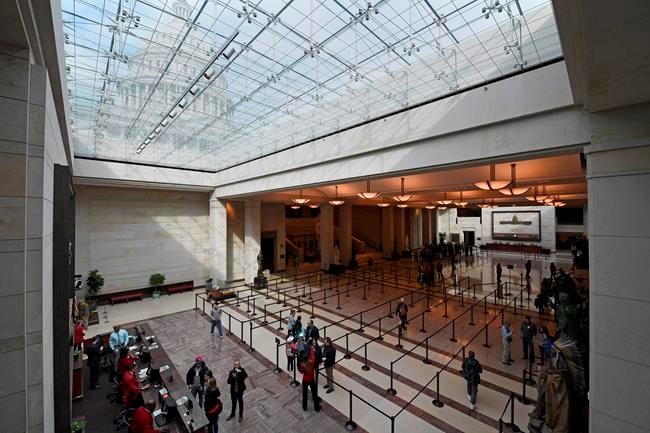WASHINGTON — The notes started popping up on Congress’ office doors this week. Elbow greetings only. A six-foot radius. And that’s for lawmakers who are taking visitors at all.
“No
Welcome to the land of “no contact meetings,” where the nation’s highest-profile hand-shakers and baby-kissers are politicking during a pandemic that wields more power than any of them. Coronavirus doesn't give a rip about who controls the House, Senate or the presidency after Election Day. Nor does it discriminate between elites and the people they govern in the bustling international city of about 30,000 workers on Capitol Hill.
“We're addressing the realities of life,” House Speaker Nancy Pelosi told reporters Thursday.
Thursday was the last day for at least a month that business-as-usual took place on Capitol Hill. The annual Friends of Ireland luncheon went on as it does every year. Visitors sporting headphones and green lanyards gaped at the dome 180 feet above them. And lawmakers chatted openly with reporters and tourists in the hallways.
But in ways large and small, the Congress' traditions and symbols were already morphing. Overnight, Capitol regulars who talk and exchange gossip went from ignoring the six-feet rule to speaking at a bit of a distance.
At the annual Friends of Ireland luncheon, Pelosi and Prime Minister Leo Varadkar shared an elbow bump. Security checks now required putting belongings in plastic bags to limit contact between officers and the public.
And visitors, millions of whom stop by every year and frequently share hallways with lawmakers, said they were acutely aware they would be among the last members of the public allowed into the Capitol until the outbreak subsides.
“It's awesome,” said Beth Welsh, a parent chaperone who said her group was on the way to Washington when their school in Winston Salem, N.C., banned all field trips. As the tour guides ushered the group out of the rotunda just before it closed, she added, “We got lucky."
Sean Lebovitz, 22 and from Pittsburgh, said the impending Capitol closure moments away was “very much” on his mind as he viewed the artwork depicting the nation's crucibles and leaders. But he said he didn't think twice about the chance to visit while he still could, virus notwithstanding.
“It's not really something I consider to be a direct threat to me or people around me,” Lebovitz said.
Shutting down the complex to visitors, a rarely-taken step, was only one example of lawmakers distancing themselves from the public and each other. One reason is that Congress, like America, is increasingly populated by an at-risk group: People over 60 years old. The average age of senators is nearly 63. House members on average are slightly younger, but many of their leaders are well past that threshold. Pelosi, for example, is 79. Senate Republican Leader Mitch McConnell is 78.
And coronavirus has come right up to Congress' door. More than a half-dozen House members and senators were self-quarantining after contact with people who had tested positive for the virus.
Many others were instituting protocols for teleworking. Rep. Seth Moulton, D-Mass., for example, issued a four-page plan for how his staff will work effective immediately, including prohibiting person-to-person contact.
“This will not be the last time the U.S. has to respond to this kind of threat,” Moulton wrote to his staff on March 9.
Members of Congress also were figuring out how to campaign amid COVID-19 without the politically vital currency of eye-to-eye contact and human connection.
Sen. Chris Coons, D-Del., said he had planned campaign door-to-door on Saturday and had been slated "all sorts" of St. Patricks Day events. His plans instead now include a campaign meeting on “upping our game in terms of live streaming video message and emails in real time.”
“This is a very physical and approximate business,” Coons said. “We may have to fundamentally rethink how am I connecting.”
Not to worry, said Sen. Bill Cassidy, R-La., a physician. On Wednesday night, he held perhaps his best-attended virtual town hall, with some 10,000 people phoning in, he said. Some were asking for medical advice, but others wanted to know what the government is doing to slow the virus' path.
“We're going to have to interact with people more remotely,” he said. “But I think with today's technology, we can do that.”
While comprehensive records about past closures of the Capitol weren't immediately available, the building is seldom closed completely to the public. No visitors were allowed immediately after a 1915 bomb threat. And restrictions were placed on access to the visitors' galleries overlooking the House and the Senate in 1954 after Puerto Rican nationalists fired from the House gallery on lawmakers, wounding five of them.
In the fall of 1918, the Capitol was closed briefly to visitors as the Spanish flu spread around the world, killing an estimated tens of millions of people, according to the chamber's historians' office.
After the Sept. 11 terrorist attacks of 2001, the Capitol was closed to tours until December.
On Thursday night, the last visitors to leave the rotunda were family members of Rep. Doug Lamborn, R-Colo.
Lamborn's daughter, Oksana, pushed a stroller containing her eight-week-old son, Oliver, who was sound asleep.
“Hopefully,” she said of the Capitol closure, “it's not forever.”
____
Associated Press Writers Alan Fram and Padmananda Rama contributed to this report.
___
Follow Kellman on Twitter at http://www.twitter.com/APLaurieKellman
___
The Associated Press receives support for health and science coverage from the Howard Hughes Medical Institute’s Department of Science Education. The AP is solely responsible for all content.
Laurie Kellman, The Associated Press



